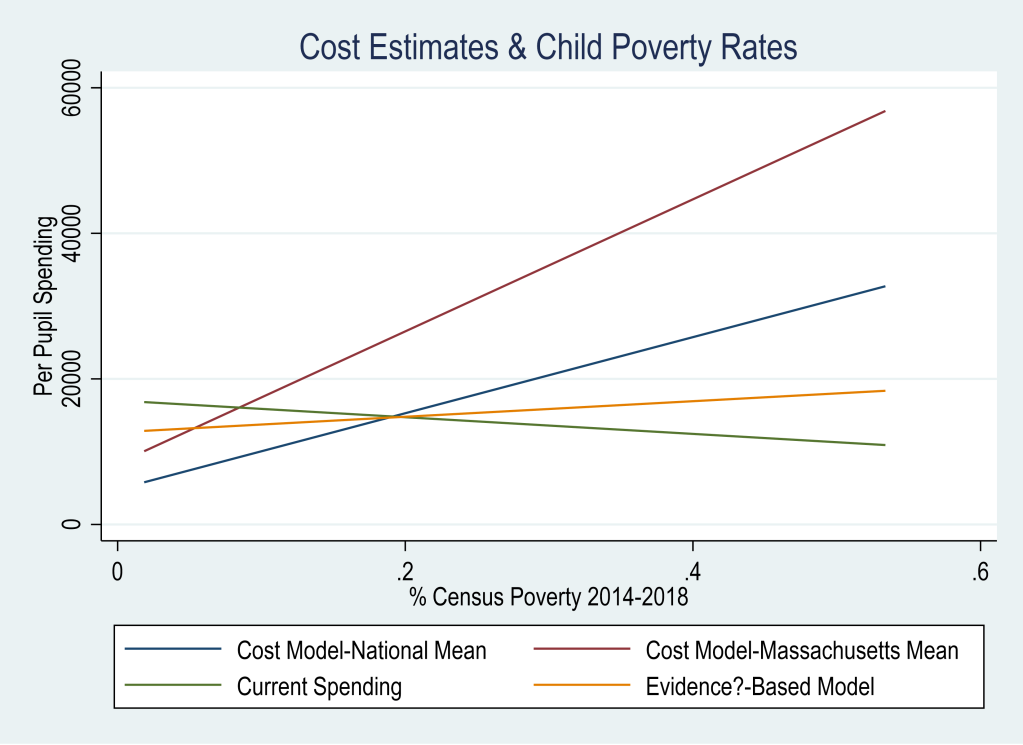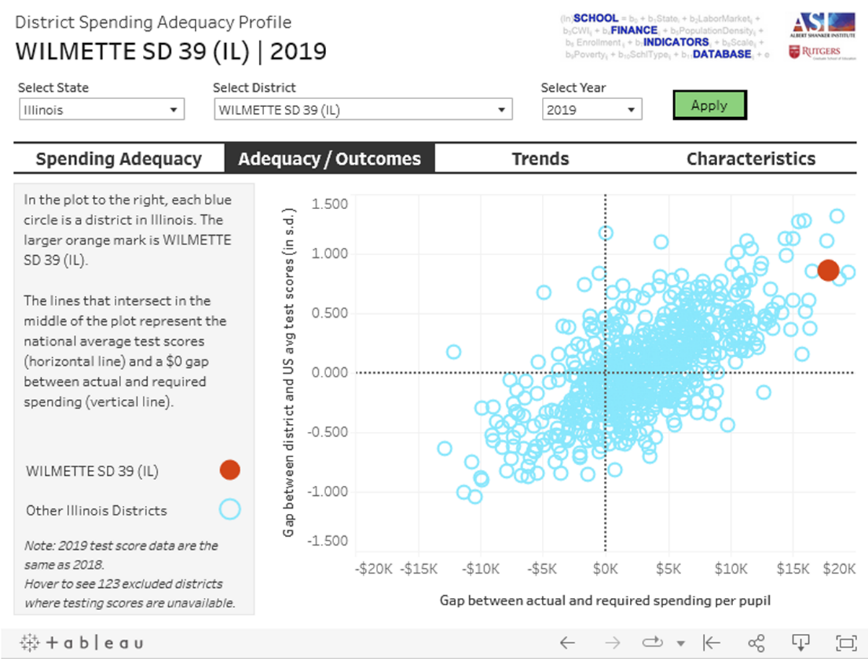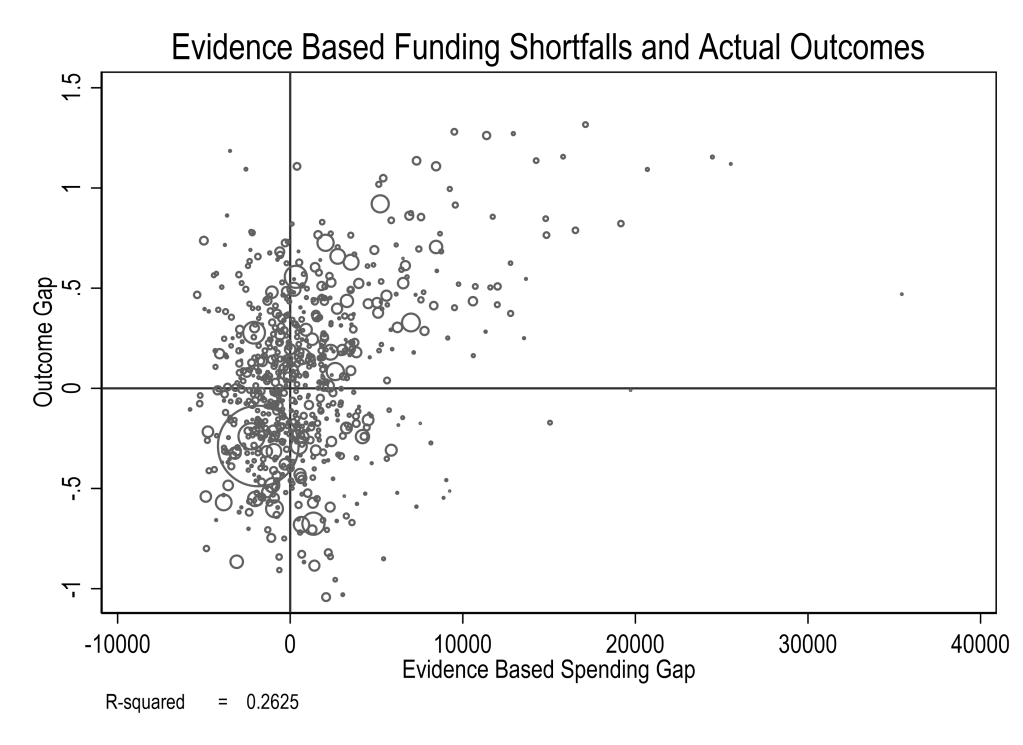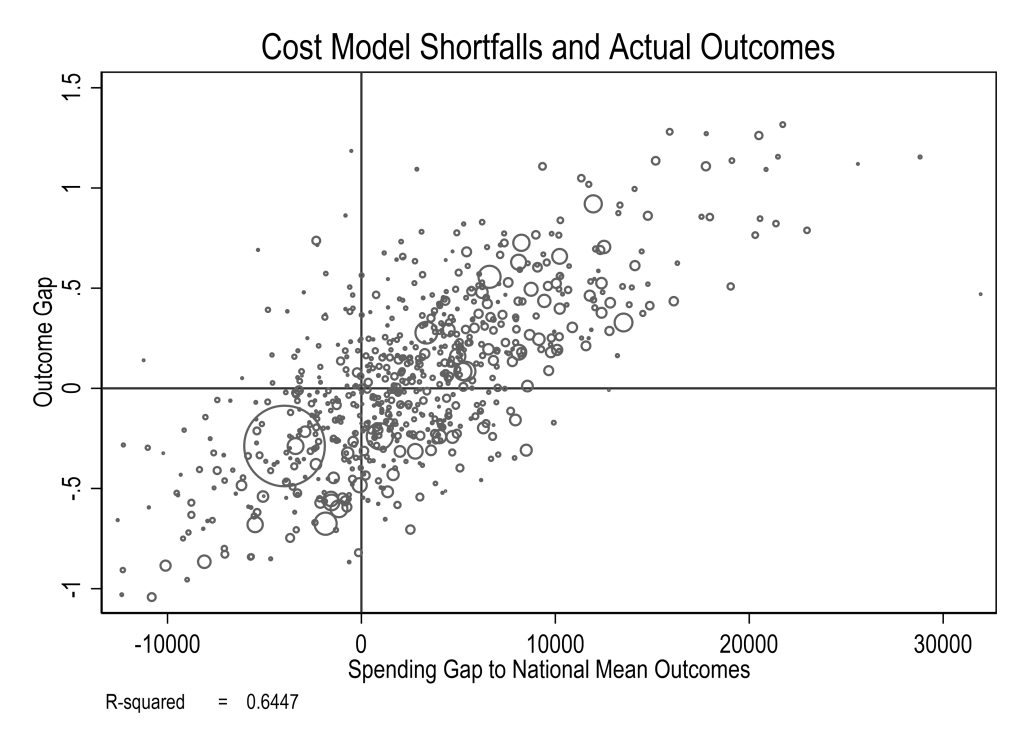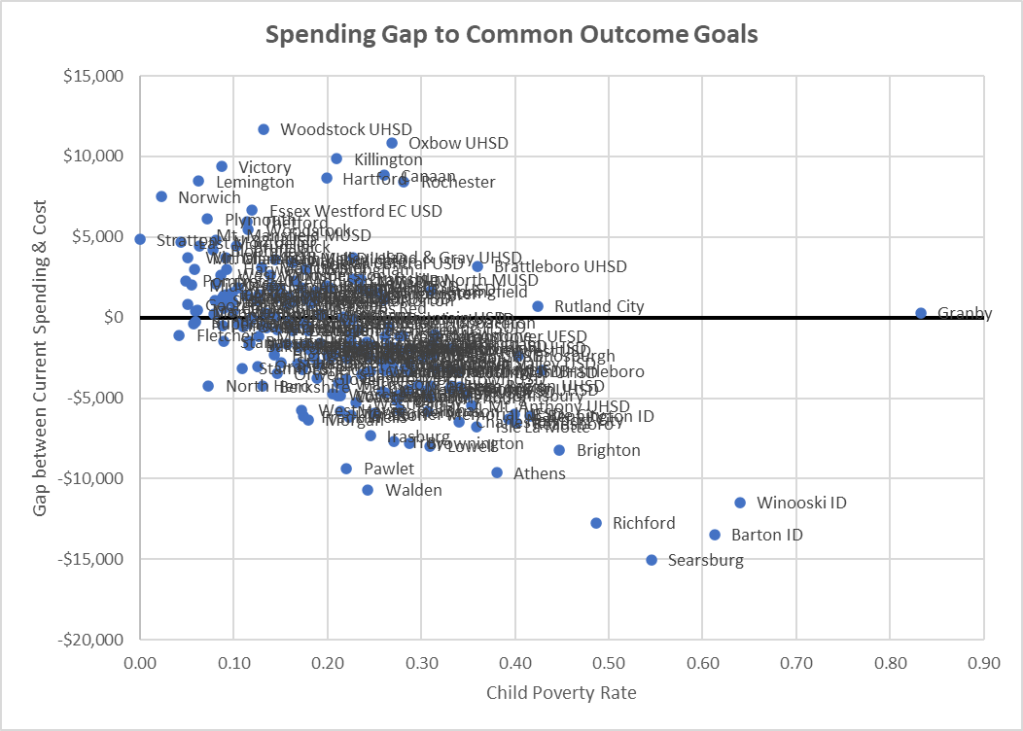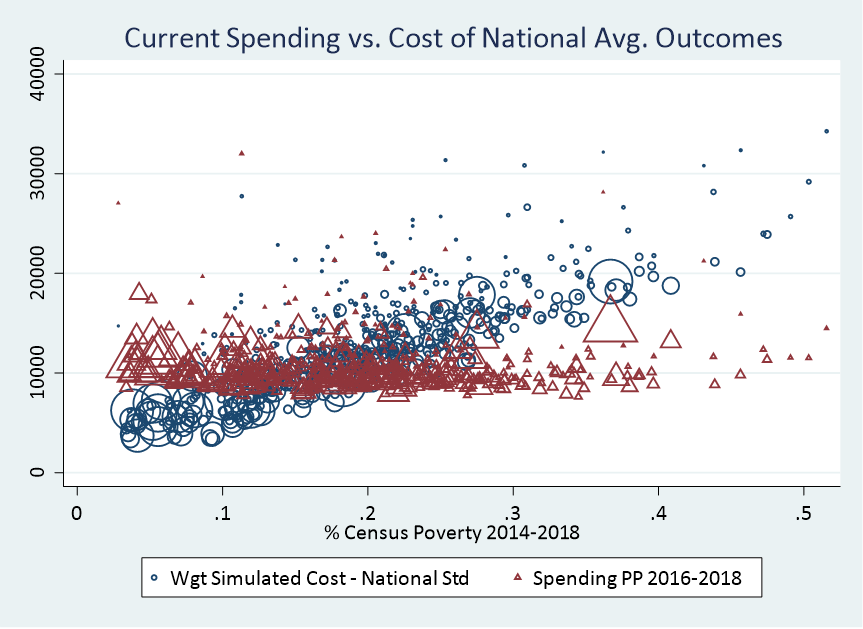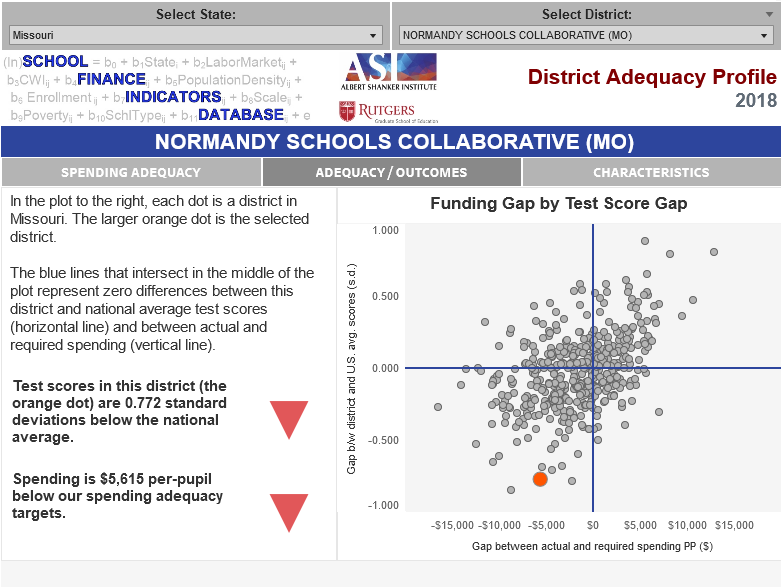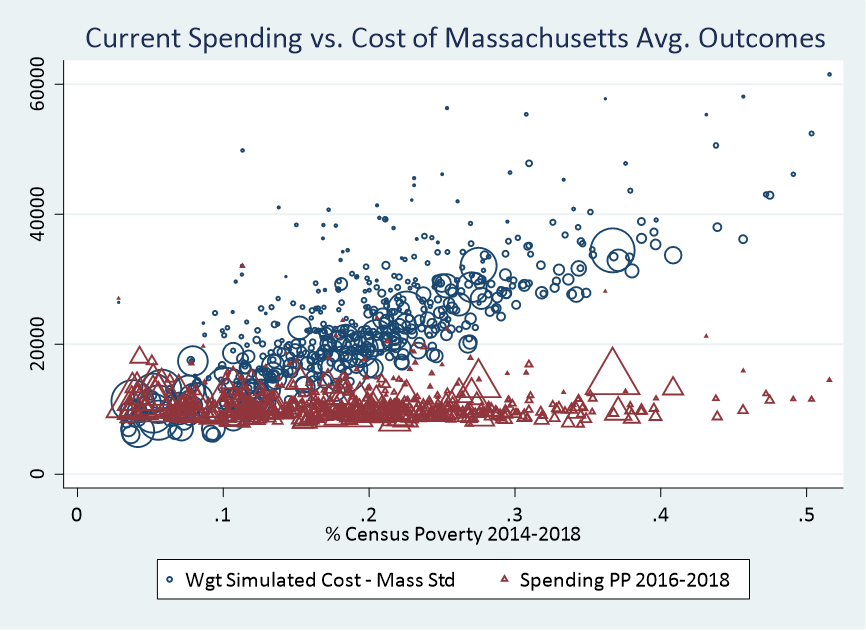There are those in the ed reform world who would tell us that existing public schools and districts are simply inefficient in their use of existing funding. That all schools and districts have enough or more than enough funding to achieve whatever goals are demanded of them, but because most of the dollars flow into a system, for example, wherein teachers are paid according to years of experience and degrees accumulated, and not directly related to student outcomes they produce, improvements cannot be achieved by providing more funding.
However, this claim is built on mythical and unfounded assumptions that an alternative system, for example, based entirely on market competition, where teachers are paid, hired and fired by the outcomes they produce (where linking pay precisely to valid, measured outcomes is feasible) would propel U.S. schools to the top of international rankings, and for even less than we currently spend.
As I explain in a 2016 report:
“To summarize, despite all the uproar about paying teachers based on experience and education, and its misinterpretations in the context of the “Does money matter?” debate, this line of argument misses the point. To whatever degree teacher pay matters in attracting high-quality educators into the profession and retaining them, it’s less about how they are paid than how much. Furthermore, the average salaries of the teaching profession, with respect to other labor market opportunities, can substantively affect the quality of entrants to the teaching profession, applicants to preparation programs and student outcomes. Diminishing resources for schools can constrain salaries and reduce the quality of the labor supply. Further, salary differentials between schools and districts might help to recruit or retain teachers in high-need settings. In other words, resources used for teacher quality matter.”[1]
Recent studies finding positive effects of school finance reforms also find that additional funding (that yielded the positive effects) tended to go toward such things as more competitive wages for teachers or smaller class sizes.[2]
This claim is also used to argue that we can learn nothing about the actual costs of producing the outcomes we desire by studying spending and spending variation in existing schools. That is, how could we possibly learn anything about efficient costs of providing the services we desire from a system that includes no institutions that presently use resources efficiently? Again, this argument is built on a false and unfounded premise.
- Existing schools and districts do, in fact, vary in the amounts of money they spend, the outcomes they achieve with that spending and efficiency with which they yield those outcomes.[3]
- Existing schools and districts vary to some degree in the ways in which they allocate resources toward those goals.
- Notably, even elite private independent schools operating on the “free market” tend not to attempt to compensate, hire or fire teachers based on student outcomes the produce. These same schools extol the virtues – from a marketing perspective – of providing particularly small class sizes.[4]
- Similarly, charter school expansion – intended to promote innovation – has not led to substantive deviation either from the way in which teachers are paid, or from the basic ways in which resources are allocated within schools.[5]
To date, no radical substitutions to the way in which public, private and charter schools provide k12 have been identified and validated as substantially more productive or efficient than existing school systems. Good schooling of any kind remains a human resource intensive endeavor, requiring a sufficient quantity of sufficiently qualified adults interacting with children, with sufficient material resources, in quality education spaces. And students have to get there and be sufficiently well nourished to thrive.
There are indeed variations across schools, within and across sectors, and those variations permit researchers to better understand what works, where, for whom and at what expense. Researchers and/or policy analysts tend to use either of two general approaches to study education costs, identifying spending levels that should generally be sufficient for achieving desired outcomes and identifying how education costs vary from one location to another across districts within a state and how those costs vary by the needs of varied student populations. One approach involves gathering focus groups of informed constituents to specify the inputs to schooling they believe are needed to get the job done. These professional judgment panels are essentially proposing a hypothesis of the programs and services needed under varied conditions and for varied student populations to achieve desired outcomes.
The preferred alternative is to construct statistical models which estimate the relationship between current district spending levels and current student outcomes, with consideration for various factors that affect the cost of achieving desired outcomes (student characteristics, district characteristics, labor market pressures) and with consideration for factors that influence whether districts are more or less likely to spend inefficiently.
This approach, called education cost function modeling has been used extensively in peer-reviewed studies of education costs and cost variation.[6] As Tom Downes, an economist from Tufts University explained back in 2004:
“Given the econometric advances of the last decade, the cost-function approach is the most likely to give accurate estimates of the within-state variation in the spending needed to attain the state’s chosen standard, if the data are available and of a high quality” (p. 9).[7]
Since that time, data quality and access have improved significantly.
The goal of education cost modeling – or any form of cost analysis – whether applied for evaluating equal educational opportunity or for producing adequacy cost estimates is to establish “reasonable marks” to provide guidance in developing more rationale state school finance systems. Only with reasonable marks in hand can one make informed judgments as to whether existing policies are wide of those reasonable marks.
Historically, funding levels for state school finance systems have largely been determined by taking the total revenue generated for schooling as a function of statewide tastes for statewide taxation and dividing that funding by the number of students in the system. That is, the budget constraint – or total available revenue – and total student enrollment have been the key determinants of the foundation level, or basic allotment. To some degree, this will always be true. But reasonable estimates of the “cost” of producing desired outcomes, given current technologies of production (the range of practices actually used/tested), may influence the taste for additional taxes by revealing that the preferences regarding taxation and the preferences regarding desired quality of public education are misaligned, meaning that one or the other should be adjusted. That is, if we find out that higher outcomes are going to cost us more, we can then have a more reasonable discussion of whether we are willing to pay that amount more for the expected gain in quality, or whether to lower our expectations. Alternatively, we can simply fly blind.
Reasonable estimates of cost may also assist courts in determining whether current funding levels and distributions are wide of a reasonable mark, or substantially misaligned with constitutional standards. Cost model estimates are not meant to be exact predictions of what student outcomes will necessarily occur next year if we suddenly adopt a state school finance system based on the cost model estimates. Cost models provide guidance regarding the general levels (predictions with error ranges) of funding increases that would be required to produce measured outcomes at a certain level, assuming that districts are able to absorb the additional resources without efficiency loss.
Studies of state school finance reform also suggest that the key to successful school finance reforms is that they are both substantive and sustained. If additional dollars to high need districts are best leveraged toward high quality preschool programs and/or early grades class size reduction, we are unlikely to see changes to college readiness outcomes the following year (or following five years). If the additional dollars are best leveraged toward increasing teacher salaries for teachers in their optimal years of experience, allowing districts to recruit and retain “better” teachers over time, we are also unlikely to see immediate returns in student test scores.
Importantly, cost model estimates are estimates based on the actual production technologies of schooling. They are based on the outcomes schools and/or districts produce under different circumstances, for different children – the actual children they serve, based on the actual assessments given, and based on the real conditions under which children attend school. Pure speculation that some alternative educational delivery system would produce better outcomes at much lower expense is certainly no basis for making a judicial determination regarding constitutionality of existing funding, and is an unlikely (though not unheard of) basis for informing statewide mandates or legislation. Cost model estimates, as well as recommendations of professional judgment and expert panels can serve to provide useful, meaningful information to guide the formulation of more rational, more equitable and more adequate state school finance systems.
[1] Baker, B. D. (2016). Does money matter in education?. Albert Shanker Institute. https://files.eric.ed.gov/fulltext/ED563793.pdf
[2] Baker, B. D. (2017). How Money Matters for Schools. School Finance Series. Learning Policy Institute. https://files.eric.ed.gov/fulltext/ED606469.pdf
[3] Grosskopf, S., Hayes, K. J., & Taylor, L. L. (2014). Efficiency in education: Research and implications. Applied Economic Perspectives and Policy, 36(2), 175-210.
[4] https://schoolfinance101.wordpress.com/2017/09/10/reality-check-innovation-substitution-in-charter-private-schools/
[5] https://schoolfinance101.wordpress.com/2017/09/10/reality-check-innovation-substitution-in-charter-private-schools/
[6] Duncombe, W., Yinger, J. (2008) Measurement of Cost Differentials In H.F. Ladd & E. Fiske (eds) pp. 203-221. Handbook of Research in Education Finance and Policy. New York: Routledge. Duncombe, W., Yinger, J. (2005) How Much more Does a Disadvantaged Student Cost? Economics of Education Review 24 (5) 513-532. Duncombe, W.D. and Yinger, J.M. (2000). Financing Higher Performance Standards: The Case of New York State. Economics of Education Review, 19 (3), 363-86. Duncombe, W., Yinger, J. (1999). Performance Standards and Education Cost Indexes: You Can’t Have One Without the Other. In H.F. Ladd, R. Chalk, and J.S. Hansen (Eds.), Equity and Adequacy in Education Finance: Issues and Perspectives (pp.260-97). Washington, DC: National Academy Press. Duncombe, W., Yinger, J. (1998) “School Finance Reforms: Aid Formulas and Equity Objectives.” National Tax Journal 51, (2): 239-63. Duncombe, W., Yinger, J. (1997). Why Is It So Hard to Help Central City Schools? Journal of Policy Analysis and Management, 16, (1), 85-113. Imazeki, J., Reschovsky, A. (2004b) Is No Child Left Beyond an Un (or under)funded Federal Mandate? Evidence from Texas. National Tax Journal 57 (3) 571-588.
[7] T. Downes, What Is Adequate? Operationalizing the Concept of Adequacy for New York State (2004), http://www.albany.edu/edfin/Downes%20EFRC%20Symp%2004%20Single.pdf.
